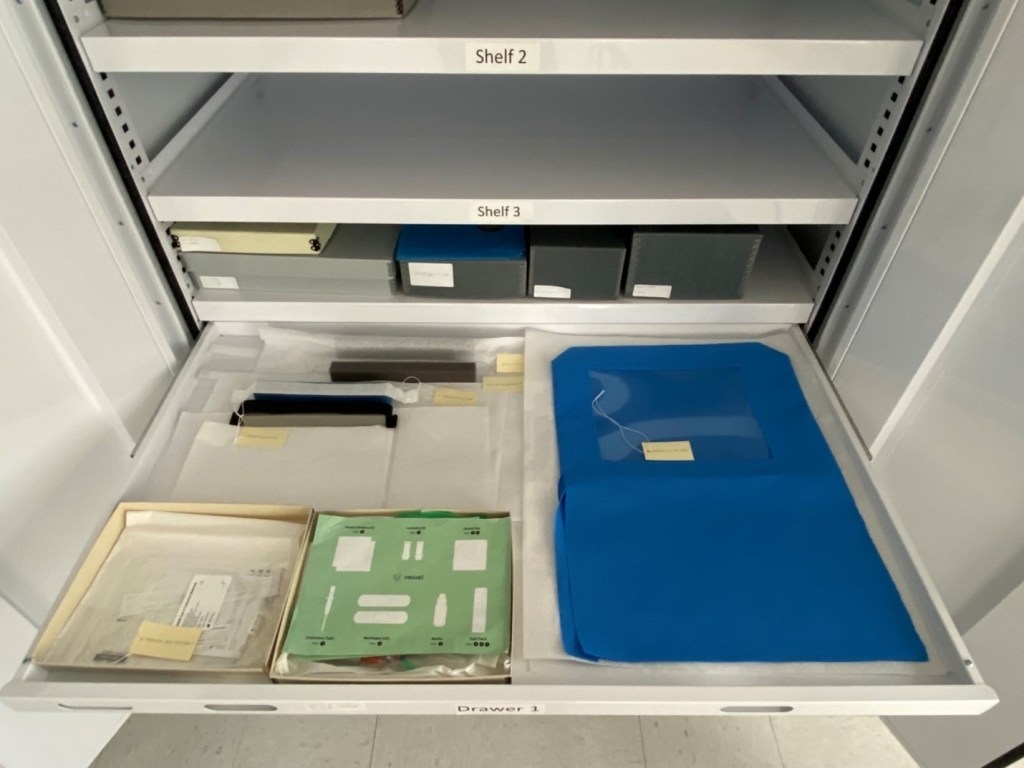
The National VA History Center (NVAHC) currently has a staff of just two full-time employees. Senior Curator, Robyn Rodgers, and I make up the team, but we have accomplished some important work through interns and graduate assistants to prepare them as history professionals.
Amy Ackman was our first graduate assistant. Amy came to us through the Public History program at Wright State University. During her time at the NVAHC, she managed the COVID artifact acquisition project, and she inventoried the initial objects acquired for the collection. Amy inventoried approximately 700 objects during her assistantship. She also accessioned the COVID objects into the collection and put them in proper storage boxes. Here are some of Amy’s thoughts on the COVID project and her time at the History Center.
Intern Olivia Holly-Johnson then utilized Amy’s work, making the COVID related objects available through an online exhibit. Olivia served as an intern through the Virtual Student Federal Internship (VSFS) program, where students work remotely on projects for federal agencies. History programs in the three VA administrations utilize VSFS interns to write articles, perform research, conduct oral interviews, and develop exhibits. Interns have contributed to many VA history projects including the 100 objects initiative. Oliva shares her experience below.
VA History is supported by talented students, who are preparing themselves for careers in public service. We in turn pass on our years of knowledge and experience to the next generation. It is very rewarding to see students grow as they are given opportunities to contribute. This is truly a win-win for the students and the history center.
By Kurt Senn
Curator, National VA History Center
Share this story
Related Stories
Curator Corner
It isn’t often that researchers who work with historic objects get to know the people who used those objects every day. Sometimes we get lucky and can link artifacts to certain facilities or buildings on a historic VA campus, but usually we must look for more hidden lines of evidence to figure out how an object fits into the history of those who care for our Nation’s Veterans. As nice as it would be, it isn’t as if many artifacts turn up labeled with their owners’ names! So, imagine my surprise when my teammates and I began sweeping Putnam Library for any historic objects left behind before the building is closed for renovation, and found just that.
As far as artifacts go, its story seemed simple: book presses like these would have been used to help maintain and repair the thousands of books read in Putnam Library ever since it first opened in 1879. The day that I first got up close and personal with the press, I noticed a woman’s name scraped into the black paint of the platen (the technical name for the big metal plate used to hold books together). It said “Helen Carson” in big, legible letters. As we carefully transported the heavy press down the many stairs inside Putnam Library, I looked at the name and thought “Hm…wonder who that is?”.
Curator Corner
Mary Lowell Putnam is tied to VA history by her generous donation of a large volume of books to the Central Branch of the National Home for Disabled Volunteer Soldiers. These books, meant to honor her son who died in the Civil War, helped foster reading advancement for the Veterans who lived there after the war and into the 20th Century. However, her life was more than just a moment in time donating books. It included a life-long study of languages and a very sharp opinion that she shared in writing throughout her life.
Curator Corner
Presidents George Washington and Abraham Lincoln are among the most easily recognizable figures in American history. Their faces are symbols of wisdom, strength, and leadership. Even today, polls consistently rank them as the greatest or most successful presidents. With that in mind, it is unsurprising that the appreciation of these legendary statesmen has deep historic roots. In honor of their birthdays, our team at the National VA History Center explored those roots through this pair of plaster busts.






